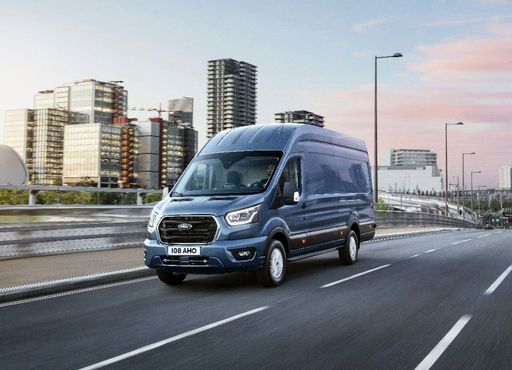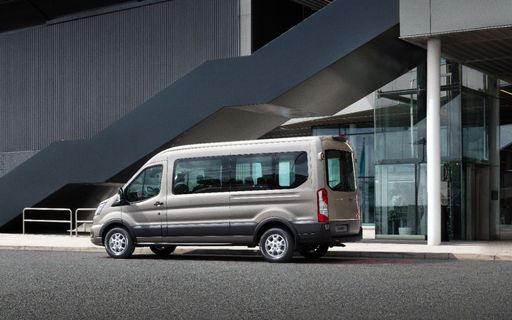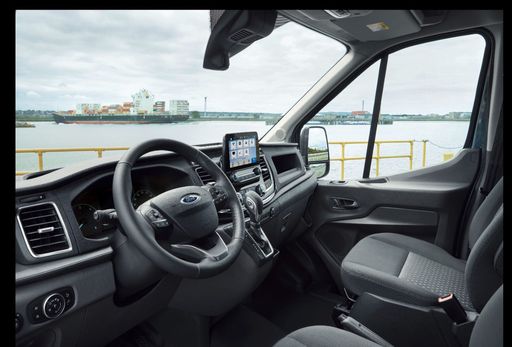Ford Transit Bus vs Nissan Primastar Transporter – Differences & prices compared
Compare performance, boot space, consumption and price in one view.
Find out now: which car is the better choice for you – Ford Transit Bus or Nissan Primastar Transporter?
The Ford Transit Bus (Bus) comes with a Diesel engine and Automatic transmission. In comparison, the Nissan Primastar Transporter (Cargo Van) features a Diesel engine with Manuel or Automatic transmission.
When it comes to boot capacity, the Ford Transit Bus offers 0 L, while the Nissan Primastar Transporter provides – depending on how much space you need. If you’re looking for more power, decide whether the 150 HP of the Ford Transit Bus or the 170 HP of the Nissan Primastar Transporter suits your needs better.
In terms of consumption, the values are 9.40 L per 100 km for the Ford Transit Bus, and 6.70 L for the Nissan Primastar Transporter.
Price-wise, the Ford Transit Bus starts at 50500 £, while the Nissan Primastar Transporter is available from 35000 £. Compare all the details and find out which model fits your lifestyle best!
Ford Transit Bus
The Ford Transit Bus is renowned for its robust performance and spacious interior, making it an ideal choice for both commercial and personal use. With its efficient handling and modern design, it effortlessly combines practicality with comfort. Its adaptability and versatility ensure it meets the demands of various driving needs, from urban transport to long-distance journeys.
details @ media.ford.com
@ media.ford.com
 @ media.ford.com
@ media.ford.com
 @ media.ford.com
@ media.ford.com
Nissan Primastar Transporter
The Nissan Primastar Transporter is a versatile vehicle that combines practicality with a modern design, making it an ideal choice for businesses in need of reliable transportation. Its spacious interior offers ample room for cargo, providing flexibility for a range of commercial needs. With efficient performance and a comfortable driving experience, the Primastar stands out as a robust option in the competitive van market.
details

|
|
|
|
|
Costs and Consumption |
|
|---|---|
|
Price
50500 - 52900 £
|
Price
35000 - 47300 £
|
|
Consumption L/100km
9.4 - 9.5 L
|
Consumption L/100km
6.7 - 7.9 L
|
|
Consumption kWh/100km
-
|
Consumption kWh/100km
-
|
|
Electric Range
-
|
Electric Range
-
|
|
Battery Capacity
-
|
Battery Capacity
-
|
|
co2
245 - 248 g/km
|
co2
176 - 208 g/km
|
|
Fuel tank capacity
70 L
|
Fuel tank capacity
80 L
|
Dimensions and Body |
|
|---|---|
|
Body Type
Bus
|
Body Type
Cargo Van
|
|
Seats
9
|
Seats
3 - 6
|
|
Doors
4
|
Doors
4
|
|
Curb weight
2338 - 2385 kg
|
Curb weight
1860 - 2049 kg
|
|
Trunk capacity
0 L
|
Trunk capacity
-
|
|
Length
5531 - 5981 mm
|
Length
5080 - 5480 mm
|
|
Width
2059 mm
|
Width
1956 mm
|
|
Height
2530 - 2533 mm
|
Height
1971 - 2486 mm
|
|
Payload
1115 - 1162 kg
|
Payload
891 - 1173 kg
|
Engine and Performance |
|
|---|---|
|
Engine Type
Diesel
|
Engine Type
Diesel
|
|
Transmission
Automatic
|
Transmission
Manuel, Automatic
|
|
Transmission Detail
Automatic Gearbox
|
Transmission Detail
Manual Gearbox, Dual-Clutch Automatic
|
|
Drive Type
Front-Wheel Drive
|
Drive Type
Front-Wheel Drive
|
|
Power HP
130 - 150 HP
|
Power HP
110 - 170 HP
|
|
Acceleration 0-100km/h
-
|
Acceleration 0-100km/h
-
|
|
Max Speed
-
|
Max Speed
160 - 185 km/h
|
|
Torque
360 - 390 Nm
|
Torque
300 - 380 Nm
|
|
Number of Cylinders
4
|
Number of Cylinders
4
|
|
Power kW
96 - 110 kW
|
Power kW
81 - 125 kW
|
|
Engine capacity
1995 cm3
|
Engine capacity
1997 cm3
|
General |
|
|---|---|
|
Model Year
2024
|
Model Year
2021
|
|
CO2 Efficiency Class
G
|
CO2 Efficiency Class
G
|
|
Brand
Ford
|
Brand
Nissan
|
Ford Transit Bus
The Versatile Ford Transit Bus from Ford
The Ford Transit Bus has always been a leader in the category of commercial passenger vehicles, and the 2024 model continues this legacy with a blend of reliability, innovation and modern design. With a range of configurations, the Ford Transit Bus is aimed at meeting the needs of businesses and individuals who require a spacious, dependable mode of transport.
Under the Bonnet: Technical Mastery
Power comes from a 2.0 EcoBlue diesel engine, available in power outputs of 130 and 150 PS. The engine is combined with an automatic transmission, ensuring a smooth drive even when fully laden. This Euro 6 compliant powerplant is designed for efficiency without sacrificing performance, sporting a fuel consumption range of 9.4 to 9.5 L/100km and an associated CO2 output of 245 to 248 g/km. Such numbers ensure that the Ford Transit Bus strikes a balance between power and economy.
Room to Spare: Exceptional Capacity and Comfort
The Ford Transit Bus is not just about getting from A to B; it’s about transporting passengers with utmost comfort. Depending on the specifications, the bus can accommodate between eight to nine passengers. The spacious interior is accompanied by an array of comfort features under the ‘Trend Automatik’ trim level, offering a practical and enjoyable ride experience for both drivers and passengers alike.
Dimensions and Practicality
Designed with practicality in mind, the Ford Transit Bus boasts dimensions that are fully suited to a variety of professional needs. Its length ranges from 5531 to 5981 mm, with a consistent width of 2059 mm and a height range from 2530 to 2533 mm. This translates to a generous loading capacity with a payload ranging from 789 to 1162 kg, making it a versatile option for businesses requiring ample cargo space alongside passenger accommodation.
Advanced Technology for Modern Roads
Aside from its primary function as a people mover, the Ford Transit Bus also shines with its technological prowess. It integrates advanced driver assistance systems aimed at ensuring both active and passive safety. This includes features that help drivers navigate through complex traffic situations and ensure maximum safety for all passengers.
A Smart Investment
The Ford Transit Bus is a competitive contender in its segment, offering not just performance and reliability but also reasonable costing. With monthly running costs ranging from €1,654 to €1,730 and cost per kilometre between 66.2 and 69.2 cents, businesses can expect an affordable operation without unexpected hikes in upkeep costs.
In conclusion, the Ford Transit Bus remains a clear front-runner among its peers, offering a combination of cutting-edge technology, impressive fuel efficiency, and a spacious, comfortable interior. Whether you are looking to enhance your fleet or need a robust transport solution, the Ford Transit Bus is a sound choice for the discerning buyer in 2024.
Nissan Primastar Transporter
Introducing the Nissan Primastar Transporter: Bridging Utility and Performance
The Nissan Primastar Transporter, a robust vehicle tailored for versatility and practicality, continues to impress with its impressive array of technical specifications and innovative features. Designed to meet the demands of a range of professional environments, the Primastar is an ideal choice for businesses seeking reliable transport solutions.
Detailed Engineering and Performance Specifications
The Nissan Primastar Transporter boasts a range of powertrains to suit different needs, with diesel engines delivering between 110 PS and 170 PS across various models. The carefully engineered 2.8 and 3.0-tonne variants feature efficient fuel consumption, ranging from 6.7 to 7.9 L/100km, underscoring Nissan's commitment to economical operation without compromising on power.
One of the standout features of the Primastar is its torque delivery. With a four-cylinder diesel engine design producing between 300 Nm and 380 Nm of torque, the vehicle ensures proficient handling even under demanding load conditions. Moreover, customers can choose between manual transmissions or an automated dual-clutch system for tailored driving preferences.
Innovation in Design and Comfort
The Primastar Transporter is not just about raw power; it offers a blend of utility and comfort. Inside, the vehicle accommodates between three to six passengers, depending on the configuration, with ample space to ensure a comfortable journey. The efficient use of cabin space and thoughtful design elements make it a leader in the transporter segment.
With a choice of trim levels including Acenta, N-Connecta, and Tekna, the Primastar offers various amenities to cater to drivers and businesses alike. Each configuration includes multiple features for safety and convenience, ensuring a modern and connected driving experience.
Cutting-edge Practicality and Safety
Nissan prioritises safety in the Primastar Transporter with advanced technology and high-quality materials used throughout its construction. The model achieves a CO2 efficiency class of G, with emissions ranging from 176 g/km to 208 g/km. The sophisticated build quality ensures a sturdy frame, while the comprehensive safety features ensure both driver and passenger security.
Additionally, the vehicle's loading capacity ranges from 891 kg to 1173 kg, accompanied by a cargo-friendly design that simplifies loading tasks. With dimensions boasting a length of up to 5480 mm and heights reaching 2486 mm, the Primastar meets the practical needs of various business operations.
A Future-forward Approach
In a market that demands flexibility and efficiency, the Nissan Primastar Transporter delivers on all fronts. It stands as a testament to Nissan's ability to blend robust engineering with modern technology, making it a preferred choice for those seeking a seamless combination of performance, economy, and adaptability in their transport solutions.
With ongoing developments in design and technology, the Primastar range is set to reinforce its status as a leader in its category, offering businesses and drivers alike a pragmatic yet innovative option for their transport needs.
Which drive types are available for the Ford Transit Bus?
Available as Front-Wheel Drive.
The prices and data displayed are estimates based on German list prices and may vary by country. This information is not legally binding.
